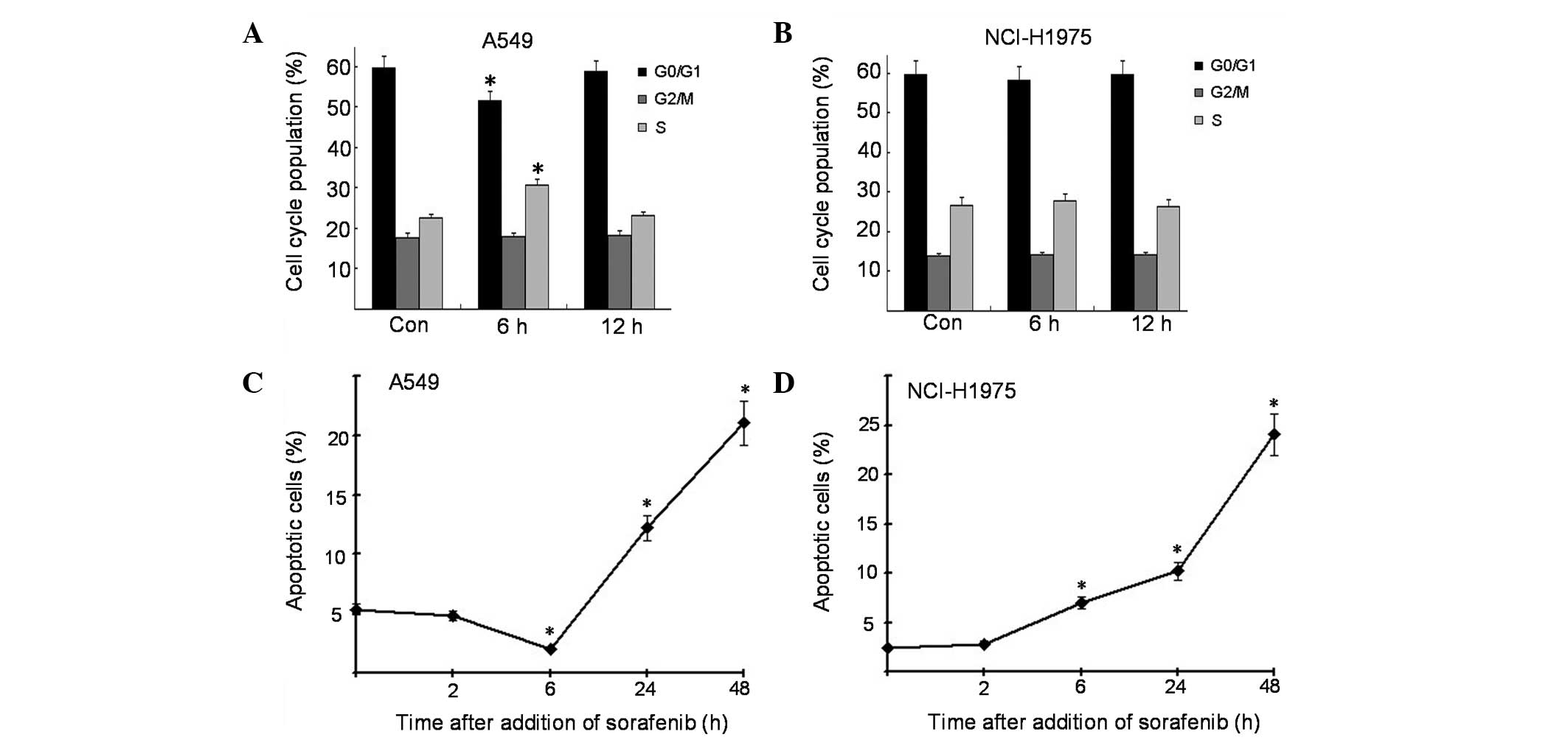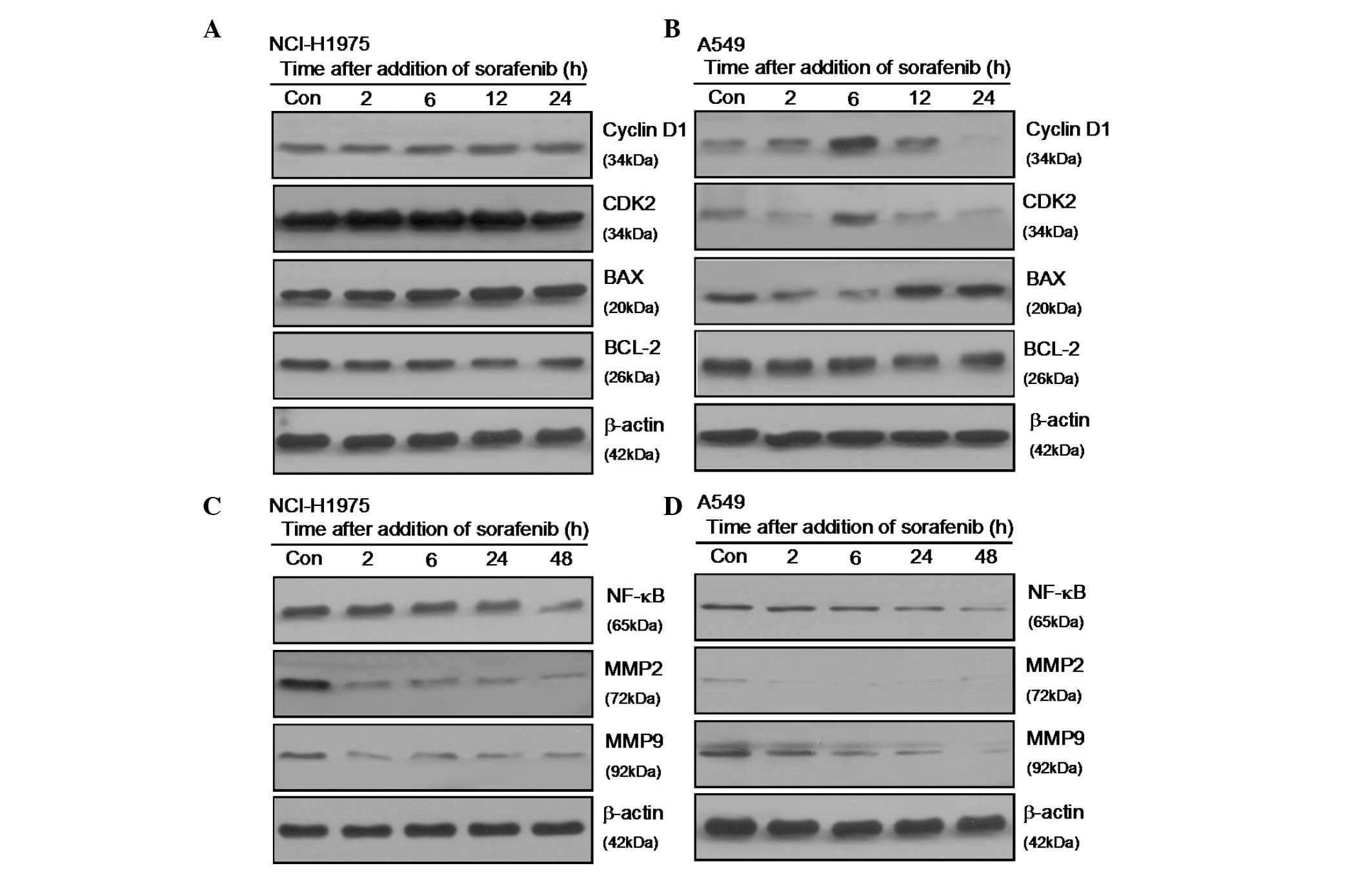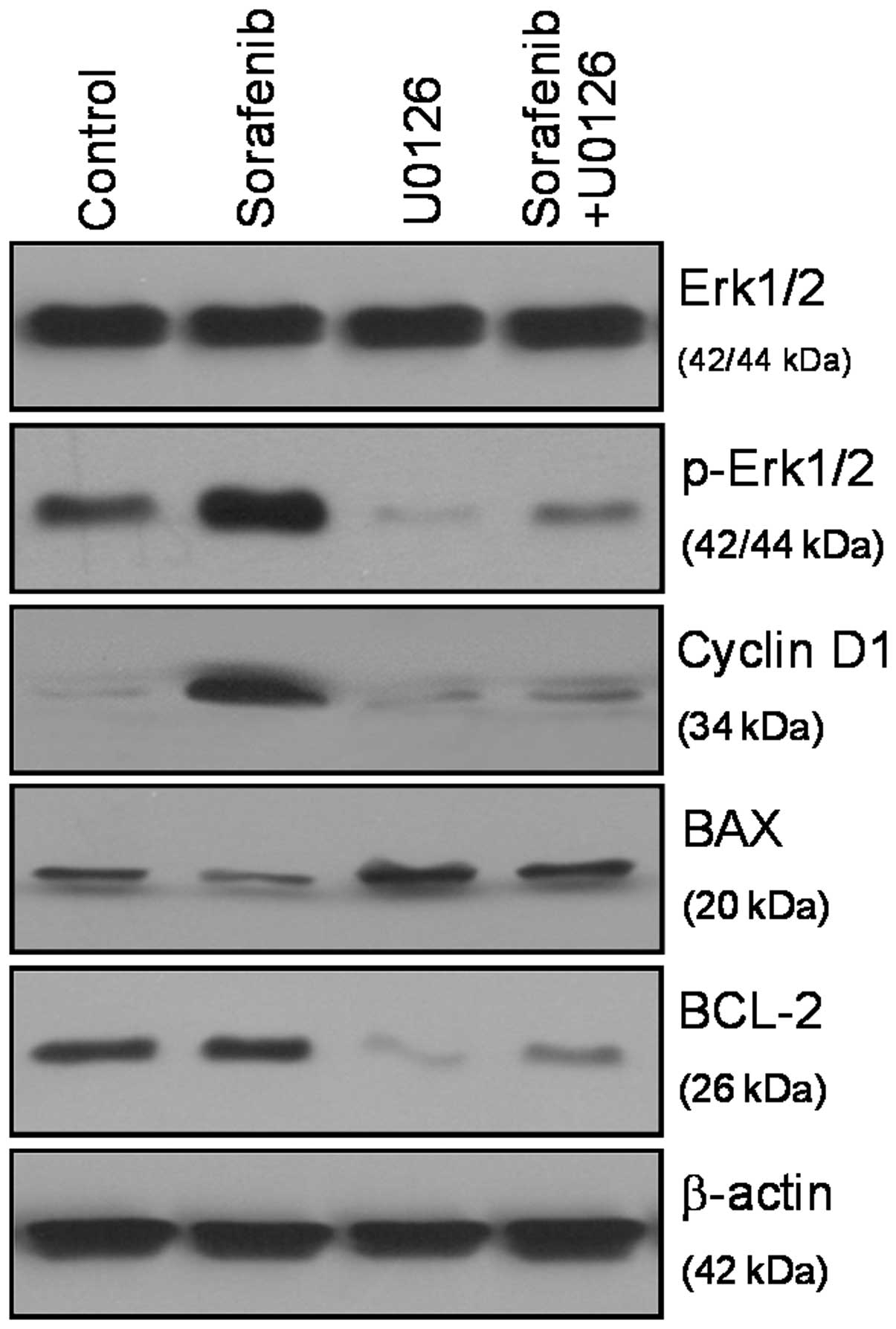Stimulatory effects of sorafenib on human non‑small cell lung cancer cells in vitro by regulating MAPK/ERK activation
- Authors:
- Published online on: November 7, 2013 https://doi.org/10.3892/mmr.2013.1782
- Pages: 365-369
Abstract
Introduction
Non-small cell lung cancer (NSCLC) accounts for ~80–85% of all lung cancer cases, and is the most common cause of worldwide cancer mortality (1). Platinum-based combination regimens offer a modest, but significant, survival advantage to NSCLC patients with advanced or metastatic disease, although the majority of patients eventually experience disease progression (2). Lung cancer is a heterogeneous disease with multiple signaling pathways influencing tumor cell survival and proliferation, and it is likely that blocking only one of these pathways allows others to act as salvage or escape mechanisms for cancer cells (3–5). Whether combined inhibition therapy has greater antitumor activity compared with single inhibition therapy is a matter of debate.
Sorafenib is a multi-kinase inhibitor that was originally developed as an inhibitor of RAF-1, a component of the extracellular signal-regulated kinase 1/2 (ERK1/2) pathway, but which was subsequently shown to inhibit multiple other kinases, including class III tyrosine kinase receptors, such as platelet-derived growth factor, vascular endothelial growth factor receptors 1 and 2, c-Kit and FLT3. Sorafenib is currently approved for the treatment of metastatic renal cell carcinoma and for advanced hepatocellular carcinoma (6,7).
Molecularly-targeted therapies, including sorafenib, which disrupts molecular defects in signaling pathways, may provide clinical benefits in the treatment of NSCLC (8). The present study aimed to systematically characterize the in vitro effects of sorafenib on proliferation, apoptosis and intracellular signaling, using two NSCLC cell lines.
Materials and methods
Cell culture and reagents
The A549 and NCI-H1975 human lung cancer cell lines were purchased from the American Type Culture Collection (Manassas, VA, USA). Cells were maintained in Dulbecco’s modified Eagle’s medium supplemented with 10% fetal calf serum, L-glutamine (5 mmol/l), non-essential amino acids (5 mmol/l), penicillin (100 U/ml), and streptomycin (100 U/ml) (Invitrogen Life Technologies, Carlsbad, CA, USA) at 37°C in a humidified 5% CO2 atmosphere. The mitogen-activated or extracellular signal-regulated protein kinases 1 and 2 (MEK1/2) inhibitor, U0126, was obtained from Cell Signaling Technology (Beverly, MA, USA). Sorafenib was purchased from Bayer Corporation (West Haven, CT, USA) and dissolved in dimethyl sulfoxide (DMSO) with cell medium to the given concentration, with a final DMSO concentration of 0.1%.
Inhibitor treatment
Stock solutions of sorafenib and U0126 were prepared at appropriate concentrations in DMSO and stored at −20°C. For treatment, inhibitor solutions were diluted 1:1,000 to appropriate working concentrations (5 or 20 μmol/l cyclopamine and 3 μmol/l U0126) in serum-free medium. Control cultures received medium containing the solvent DMSO at a concentration of 0.1%.
Cell viability assay
Cell proliferation was determined using an MTT viability assay, the most commonly used assay for determining cell growth and death. The MTT survival assay has been described in detail in previous studies (9). Exponentially growing cells were recultured (5,000 cells/well) overnight in 96-well tissue culture plates. Up to 20 μl MTT (Sigma-Aldrich, St. Louis, MO, USA) was directly added to the media in each well, with a final concentration of 2 mg/ml. After 4 h incubation, the medium containing MTT was discarded, and 120 μl DMSO was added for 10 min. The absorbance was measured using an enzyme-linked immunosorbent assay reader (Bio-Tek, Inc., Winooskie, VT, USA) at 570 nm, with the absorbance at 630 nm as the background correction. The cell viability is expressed as the percentage of untreated controls. All experiments were performed at least three times.
Apoptosis assay
Apoptosis analysis by a flow cytometer Annexin V-fluorescein isothiocyanate (FITC)/propidium iodide (PI) kit (BD Biosciences, Sparks, MD, USA) was used to measure the percentage of apoptosis induced by sorafenib. Cells were removed with trypsin and collected into centrifuge tubes together with the culture medium. A total of 5 μl Annexin V-FITC solution and 10 μl PI (1 μg/ml) were added to these cells for 30 min in the dark. Flow cytometry and Annexin V-FITC apoptosis analysis were performed as previously described (10). Apoptotic rates were calculated from 10,000 cells using ModFit LT software with FACSCalibur (both Becton Dickinson, San Jose, CA, USA).
Cell cycle assays
The cells were removed with trypsin and collected in centrifuge tubes, together with the culture medium. The contents were centrifuged for 5 min at 1,800 × g. The supernatant was poured out, washed once with 1X phosphate-buffered saline (PBS), and centrifuged for a subsequent 5 min. The cells were then fixed with 5 ml pre-cooled 70% ethanol for at least 4 h. The fixed cells were centrifuged and washed with 1X PBS. Following centrifugation, the cell pellets were resuspended in 500 μl PI (10 μg/ml) containing 300 μg/ml RNase (Sigma-Aldrich). The cells were incubated on ice for 30 min, and filtered with a 53 μm nylon mesh. The cell cycle distribution was calculated from 10,000 cells using ModFit LT software (Becton Dickinson) using FACSCalibur.
Western blot assay
Cell lysates were prepared and western blot analysis was performed as previously described (10). Equal aliquots of total cell protein (50 μg/lane) were electrophoresed on sodium dodecyl sulfate-polyacrylamide gels, transferred onto polyvinylidene fluoride membranes, and blotted using the primary antibodies: β-actin (C-4), cyclin D1 (A-12), cyclin-dependent kinase (CDK)2 (M2), nuclear factor (NF)-κB (P65A), matrix metallopeptidase (MMP)-2 (2C1), MMP-9 (6-6B), BAX (P-19) and Bcl-2 (C-2; all 1:1,000 dilution; Santa Cruz Biotechnology, Inc., Santa Cruz, CA, USA), followed by the secondary antibodies horseradish peroxidase-labeled goat anti-mouse (GAM-007) and goat anti-rabbit (SC-2004) IgG, and phospho-ERK1/2 (T202/Y204) and ERK1/2 (1:1,000 dilution; Cell Signaling Technology, Beverly, MA, USA). The protein bands were visualized using an enhanced chemiluminescence system (Union Bioscience Corporation, Hangzhou, China) with prestained markers as molecular size standards. At least three independent experiments were performed for each cell type studied.
Statistical analysis
Data are presented as the mean ± standard deviation. Experimental results of the treated and control groups were compared using two-tailed Student’s t-test. All statistical tests were performed using SPSS version 17.0 (SPSS Inc., Chicago, IL, USA). P≤0.05 was considered to indicate a statistically significant difference.
Results
Sorafenib decreases breast cancer cell proliferation
MTT viability assays were conducted to elucidate the potential biological effects of sorafenib in different lung cancer cells. As shown in Fig. 1A, the NCI-H1975 cells treated with cyclopamine exhibited significant reduction in proliferation rates compared with the control cells at the two concentrations (5 and 20 μM), and sorafenib also markedly inhibited A549 cells at a concentration of 20 μM. However, at a concentration of 5 μM and 6 h time point, the proliferation rate was increased compared with the control cells (Fig. 1B).
Effect of sorafenib on cell cycle distribution and apoptosis in different cells
To investigate the different proliferation results in sorafenib-treated lung cancer cells, cell cycle proliferation and apoptosis was examined by flow cytometry. The results showed that sorafenib decreased the proportion of A549 cells in the G1 phase of the cell cycle and increased that of cells in the S phase (Fig. 2A), and the cell cycle redistribution was not observed in NCI-H1975 cells at this time point (Fig. 2B). The apoptosis assay revealed that sorafenib decreased the proportion of apoptotic cells in A549 cells at the 6 h time point, which was not observed in NCI-H1975 cells (Fig. 2C and D). These data indicate that cell cycle distribution and apoptosis were involved in the proliferation of sorafenib-treated lung cancer cells.
Sorafenib affects the expression of cell cycle, invasion and apoptosis-associated proteins
The alterations in the cell cycle, invasion- and apoptosis-associated proteins in sorafenib-treated cells were evaluated and compared with the control cells using western blot analysis. As shown in Fig. 3A, the expression levels of cyclin D1, CDK2, NF-κB, MMP2, MMP9 and Bcl 2 decreased significantly in sorafenib-treated NCI H1975 cells. In A549 cells, sorafenib significantly enhanced the expression of cyclinD1 and CDK2, and suppressed BAX expression at the 6 h time point (Fig. 3B). With regard to invasion-associated proteins, there was no difference between the two cell lines (Fig. 3C and D). Sorafenib regulates the proliferation and apoptosis of A549 cells by activating the ERK1/2 signaling pathway. To examine the effects of sorafenib on the ERK1/2 signaling pathway in A549 cells, immunoblot analysis was performed with antibodies specific for phosphorylated ERK1/2. The results of this study reveal that sorafenib markedly enhanced ERK phosphorylation in A549 cells at the 5 μM concentration and 6 h time point, but had no marked effect on the expression of this protein (Fig. 4). Phosphorylation of ERK1/2 is a key initial response to cell cycle distribution and apoptosis. With regard to downstream proteins, sorafenib markedly upregulated the expression of cyclin D1, and inhibited the expression of BAX at the same concentration and time point. The specific signaling cascade involved in this response was investigated using the MEK1/2 inhibitor (U0126) specific to the MAPK/ERK pathway. The increased phospho-ERK1/2 following sorafenib-treatment was inhibited by U0126, as well as the downstream protein cyclin D1, Bcl-2 and BAX (Fig. 4), which suggests that sorafenib mediates cell cycle distribution and apoptosis by modulating the ERK signaling pathway.
Discussion
NSCLC remains a leading cause of mortality worldwide among patients diagnosed with malignancies (11). The standard therapeutic concept of lung cancer is based on cisplatin chemotherapy. However, during the last few decades, no significant improvement in the prognosis of patients with lung cancer has been achieved (12).
Sorafenib, an oral multi-kinase inhibitor, inhibiting serine/threonine Raf kinases and RTKs, including vascular endothelial growth factor receptor and platelet-derived growth factor receptor-b, is currently used for the therapy of advanced renal carcinoma. Furthermore, antitumor activity and an improved outcome have also been observed for patients with other carcinomas, including hepatocellular carcinoma and NSCLC (6,7,13–16).
In the present study, it was observed that at a low concentration and early time point, sorafenib is capable of significantly stimulating the proliferation of A549 cells, which was not observed in NCI-H1975 cells. The cell cycle assay showed that sorafenib decreased the proportion of A549 cells in the G1 phase of the cell cycle, and increased that of cells in the S phase, which was different with NCI-H1975 cells. The apoptosis assay also revealed that sorafenib decreased the proportion of apoptotic cells in A549 cells at a specific time point.
Phosphorylated ERK is a key downstream target of the Ras/Raf/MEK/ERK signaling pathway, and dysregulation of this pathway occurs in approximately one-third of all human cancers (17). ERK is the terminal kinase in this pathway. During the phosphorylation cascade, ERK1/2 is activated by mitogen-activated protein kinases. Mitogen-stimulated cell growth, through survival/apoptosis and cell cycle control, is frequently linked to phosphorylated ERK translocation from the cytoplasm to the nucleus and to the initiation of transcriptional activation of cell regulatory genes (18,19). Therefore, the current study focused on the effects of sorafenib on the phosphorylation status of ERK1/2. As described in the results, high concentrations of sorafenib decreased the phosphorylation levels of ERK-1/2. Notably, a significant stimulatory effect of sorafenib was observed at low concentrations on ERK-1/2 phosphorylation. To further elucidate the underlying signaling pathways, the MEK inhibitor U0126 was used. The results showed that the increased phospho-ERK1/2 following sorafenib-treatment was inhibited by U0126, as well as the downstream protein cyclin D1, Bcl-2 and BAX, which suggests that sorafenib mediates cell cycle distribution and apoptosis by modulating the ERK signaling pathway.
The current observations demonstrate the antimigratory and antiproliferatory effects of sorafenib in different human NSCLC cells. However, the stimulatory effects at low concentrations of sorafenib in certain cancer cells may have marked consequences for this antitumor drug. This may be particularly relevant for selecting dosing regimens that avoid low plasma concentrations of sorafenib in order to optimize the treatment with this promising antitumor drug.
References
|
Kyle F and Spicer J: Targeted therapies in non-small cell lung cancer. Cancer Imaging. 8:199–205. 2008. View Article : Google Scholar : PubMed/NCBI | |
|
Ray MR, Jablons D and He B: Lung cancer therapeutics that target signaling pathways: an update. Expert Rev Respir Med. 4:631–645. 2010. View Article : Google Scholar : PubMed/NCBI | |
|
Zhang X, Li Y, Li H, et al: Combined EGFR and VEGFR versus single EGFR signaling pathways inhibition therapy for NSCLC: a systematic review and meta-analysis. PLoS One. 7:e401782012. View Article : Google Scholar : PubMed/NCBI | |
|
Larsen JE, Cascone T, Gerber DE, et al: Targeted therapies for lung cancer: clinical experience and novel agents. Cancer J. 17:512–527. 2011. View Article : Google Scholar : PubMed/NCBI | |
|
Pal SK, Figlin RA and Reckamp K: Targeted therapies for non-small cell lung cancer: an evolving landscape. Mol Cancer Ther. 9:1931–1944. 2010. View Article : Google Scholar : PubMed/NCBI | |
|
Ramakrishnan V, Timm M, Haug JL, et al: Sorafenib, a multikinase inhibitor, is effective in vitro against non-Hodgkin lymphoma and synergizes with the mTOR inhibitor rapamycin. Am J Hematol. 87:277–283. 2012. View Article : Google Scholar : PubMed/NCBI | |
|
Wilhelm S, Carter C, Lynch M, et al: Discovery and development of sorafenib: a multikinase inhibitor for treating cancer. Nat Rev Drug Discov. 5:835–844. 2006. View Article : Google Scholar : PubMed/NCBI | |
|
Wilhelm SM, Adnane L, Newell P, et al: Preclinical overview of sorafenib, a multikinase inhibitor that targets both Raf and VEGF and PDGF receptor tyrosine kinase signaling. Mol Cancer Ther. 7:3129–3140. 2008. View Article : Google Scholar : PubMed/NCBI | |
|
Jiao Y, Sun KK, Zhao L, et al: Suppression of human lung cancer cell proliferation and metastasis in vitro by the transducer of ErbB-2.1 (TOB1). Acta Pharmacol Sin. 33:250–260. 2012. View Article : Google Scholar : PubMed/NCBI | |
|
Sun KK, Zhong N, Yang Y, Zhao L and Jiao Y: Enhanced radiosensitivity of NSCLC cells by transducer of erbB2.1 (TOB1) through modulation of the MAPK/ERK pathway. Oncol Rep. 29:2385–2391. 2013.PubMed/NCBI | |
|
Scagliotti G, Novello S, von Pawel J, et al: Phase III study of carboplatin and paclitaxel alone or with sorafenib in advanced non-small-cell lung cancer. J Clin Oncol. 28:1835–1842. 2010. View Article : Google Scholar : PubMed/NCBI | |
|
Bearz A, Berretta M, Lleshi A and Tirelli U: Target therapies in lung cancer. J Biomed Biotechnol. 2011:9212312011. View Article : Google Scholar : PubMed/NCBI | |
|
Rose A, Grandoch M, vom Dorp F, et al: Stimulatory effects of the multi-kinase inhibitor sorafenib on human bladder cancer cells. Br J Pharmacol. 160:1690–1698. 2010. View Article : Google Scholar : PubMed/NCBI | |
|
Bareford MD, Park MA, Yacoub A, et al: Sorafenib enhances pemetrexed cytotoxicity through an autophagy-dependent mechanism in cancer cells. Cancer Res. 71:4955–4967. 2011. View Article : Google Scholar | |
|
Takahashi O, Komaki R, Smith PD, et al: Combined MEK and VEGFR inhibition in orthotopic human lung cancer models results in enhanced inhibition of tumor angiogenesis, growth, and metastasis. Clin Cancer Res. 18:1641–1654. 2012. View Article : Google Scholar : PubMed/NCBI | |
|
Takezawa K, Okamoto I, Yonesaka K, et al: Sorafenib inhibits non-small cell lung cancer cell growth by targeting B-RAF in KRAS wild-type cells and C-RAF in KRAS mutant cells. Cancer Res. 69:6515–6521. 2009. View Article : Google Scholar : PubMed/NCBI | |
|
Marampon F, Gravina GL, Di Rocco A, et al: MEK/ERK inhibitor U0126 increases the radiosensitivity of rhabdomyosarcoma cells in vitro and in vivo by downregulating growth and DNA repair signals. Mol Cancer Ther. 10:159–168. 2011. View Article : Google Scholar : PubMed/NCBI | |
|
Klein PJ, Schmidt CM, Wiesenauer CA, et al: The effects of a novel MEK inhibitor PD184161 on MEK-ERK signaling and growth in human liver cancer. Neoplasia. 8:1–8. 2006. View Article : Google Scholar : PubMed/NCBI | |
|
Shukla A, Hillegass JM, MacPherson MB, et al: ERK2 is essential for the growth of human epithelioid malignant mesotheliomas. Int J Cancer. 129:1075–1086. 2011. View Article : Google Scholar : PubMed/NCBI |













